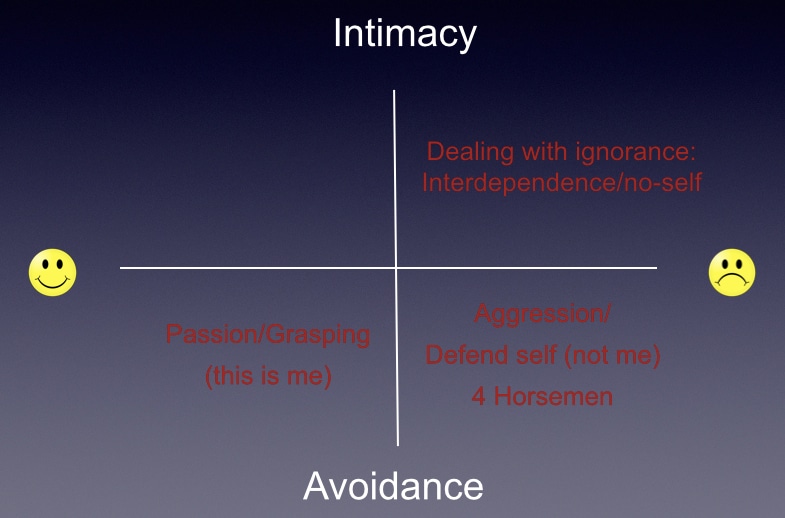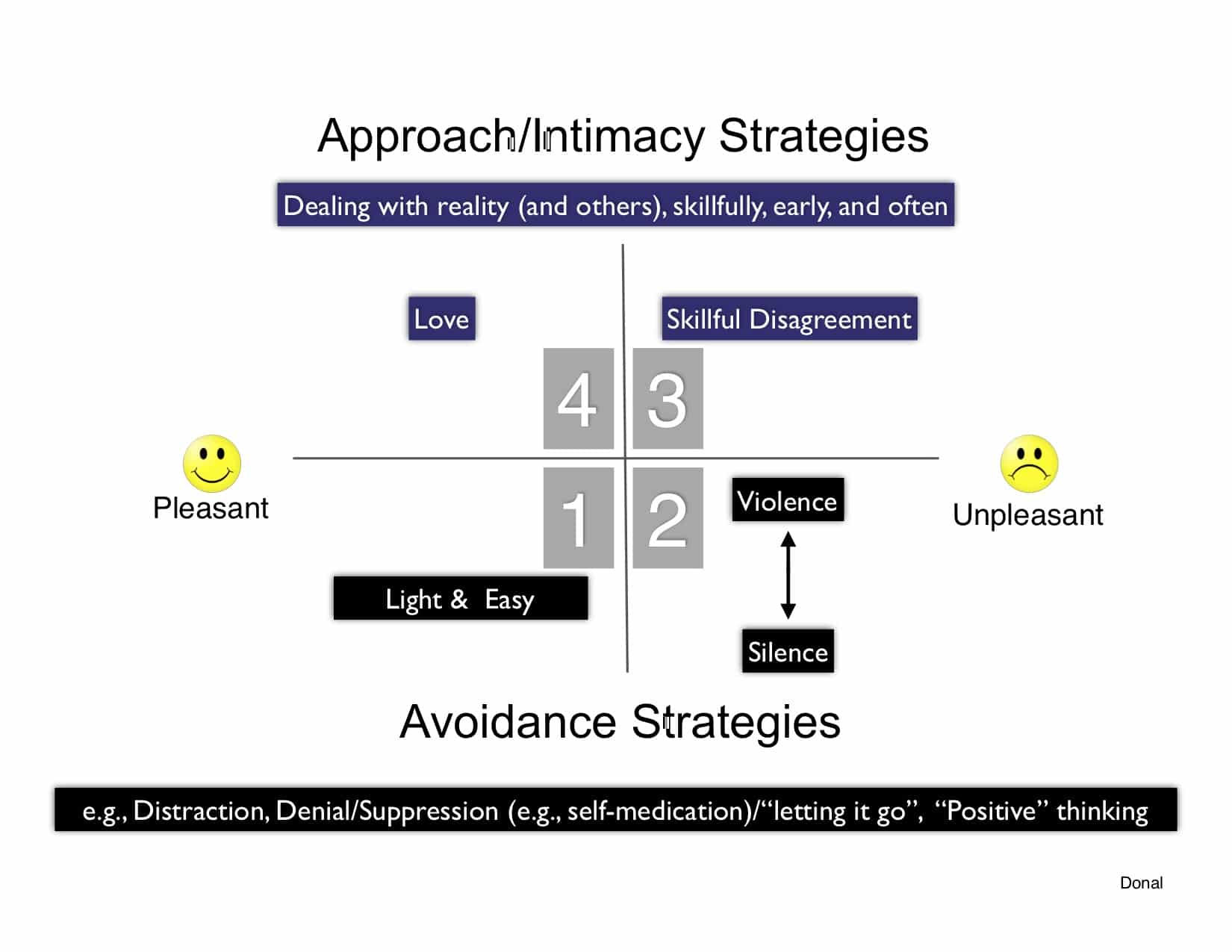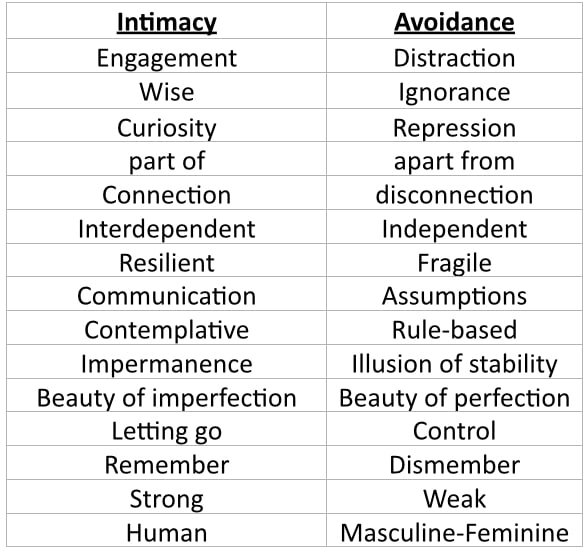Connection Strategies for Thriving
One Solution. Two Changes.
The only thing we need to do to achieve one planet thriving is deal with reality early, often, and skillfully. This means evolving from an industrial to an ecosystem culture, individually and in our relationships. There are two changes needed to achieve this.
First, we need to equalize power of all kinds at all levels of our culture. Due to power asymmetries developed through unfortunate feedback loops, we ignore important aspects of reality by listening to the lucky and ignoring the unlucky. Therefore, our view of reality is skewed, resulting in physical and social ways of life that are unsustainable and destructive.
Second, we need to use the data of unpleasant emotion. Currently, we mostly avoid unpleasant emotion internally and in relationships with others. Thus, avoidance skews our view of reality and limits our ability to navigate reality skillfully. This article is primarily about the second issue though it has many connections to the first.
The Second Change.
Love is easy when we agree. Deep, reliable, and loyal love (of ourselves, our partners, and our community) is known mainly through our ability to connect when we disagree. Why? Because this is the hard part of most relationships.
There are two critical necessities for a good relationship: (1) Getting along, and (2) Dealing skillfully with unpleasant emotion when we don’t get along. Much of our culture focuses on the first. Thus, we are not good at the second.
The illustration represents the Quadrants Framework and will further the discussion.
The X-axis: Life presents us with events that make us feel pleasant emotion (left) and unpleasant emotion (right) and everything in between. When life goes the way we want it to, we feel pleasant emotion and want more of it (Buddhists would recognize this as passion, one of the three poisons). So, for example, there is a large scientific literature on the fact that we feel pleasant emotion when we achieve things that are consistent with how we want to be (e.g., I get an A on a test when being smart is an important value for me). We like ourselves and like other people when we are compatible and it’s easy to get along under those conditions.
Sometimes, though, life gives us situations that are not compatible with what we’d like — that’s the right side of the x-axis. This might occur if we fail a test or if someone we’re talking to disagrees with us. When that happens, we feel unpleasant emotion and try to avoid those things (Buddhists would recognize another poison here, aggression). Makes sense. Who wouldn’t want to avoid disagreement and unpleasant emotion?!
In permaculture design, we strive to harness or moderate the energies of an ecosystem which include sun, wind, and precipitation. The energy of social systems is emotion.
The Y-axis: This axis represents the continuum of strategies available to us in interacting with parts of ourselves and each other. One of my claims is that our culture relies principally on avoidance strategies to deal with the full continuum of pleasant-to-unpleasant emotion. The key to an avoidance strategy is to avoid reality. Examples include: distraction, self-medication, dismissing others through criticism or “otherizing”, “letting it go” (which is often just suppression), “positive” thinking, or other forms of legislating emotions or speech: “Don’t be so negative”, “Lighten up”, “We don’t say ‘hate'”, “You shouldn’t feel sad”, “stop whining”, “suck it up”. I think of statements like these as language traps because we are trained in our culture to use these phrases to describe emotion (“I fell apart”, “I lost it”) and unconsciously take them as truth. In fact, they are are actually false criticisms of normal emotion. As such they fall under the category of violence, a characteristic of quadrant 2 (below).
The table below illustrates a range of concepts associated with intimacy or avoidance.
A brief sidebar on so-called “positive” thinking. “Positive thinking” is often a misnomer because something that feels unpleasant to discuss is not necessarily negative for our lives; on the contrary, unpleasant aspects of reality are often positive for our lives (see this article on pleasant negatives and unpleasant positives). With just a little thought it becomes clear that we can have unpleasant positive thinking (e.g., it’s unpleasant to see a rattlesnake on a hike, but being aware of it could very well save your life, a very positive thing) and pleasant negative thinking (e.g., I’m enjoying my hike without stress because I don’t see the rattlesnake, but that means I’m less likely to avoid being bitten). Often people advocating “positive” thinking are simply advocating that we maintain pleasant emotion by avoiding unpleasant reality — what we might call “pleasant delusional thinking”. More on the orthogonal relationship between positive-negative and pleasant-unpleasant here. Also, see this post on unrealistic optimism as well as a reply to Kahlil Gibrans’ observation about optimism and the rose.
In any case, some of these avoidance strategies, like distraction, are useful, often as a short-term break so we can re-center and then re-engage in more skillful ways. Sometimes these avoidance strategies are not just helpful, they are necessary. Sometimes, however, we can avoid reality so successfully we create more suffering than necessary. The dysfunctional status quo of our current culture is caused by an over-emphasis on avoidance strategies. We are so eager to feel pleasant emotion and avoid unpleasant emotion that we are failing to confront significant problems with our planet, such as deforestation, loss of topsoil, desertification, and climate change. Thus, intimacy strategies are critical for learning to thrive on one planet’s worth of resources, the main theme of this site.
Life is better and more resilient when we also have the ability to engage in intimacy strategies (the top part of the y-axis) in addition to these avoidance strategies. Intimacy is not a euphemism for sex or even physical intimacy though it includes both. Intimacy is much broader: it involves dealing with (or connecting with) reality, early, often, and skillfully. Intimacy strategies involve really knowing oneself or the other person we are interacting with. Without intimacy strategies, we’re not very good at speaking skillfully when disagreement, incompatibilities, or unpleasant emotion arise because we will be using avoidance strategies that, by definition, avoid one or more aspects of reality.
Pleasant Episodic Self vs. Deep Self. Without intimacy strategies, we achieve high degrees of compatibility by focusing on only surface and pleasant aspects of ourselves and by dismissing and otherizing people based only on their surface and unpleasant aspects. For example, some of us do not acknowledge anything but pleasant aspects of ourselves or others. We interact by telling pleasant (often funny) stories about ourselves and others or by confining our conversations to light and easy episodes (“I did this on this date and it was funny”). There’s nothing wrong with this. It’s the cotton candy of social interaction: it’s sweet and fun and light but doesn’t last long and isn’t nourishing. It can be lonely, lead to silence and violence, and isn’t reality.
Avoidance strategies come with a world view that emphasizes following the rules, authoritarianism, hierarchy, and personal control. Intimacy strategies emphasize using all the data of a moment (as in mindfulness and other contemplative traditions), views rules as guidelines, and emphasize interdependence. Avoidance is associated with domestication, civilization, appropriateness, and an emphasis primarily on knowledge. Intimacy is more about wildness and wisdom and is critical for moving beyond our current dysfunctional status quo toward one planet thriving. Avoidance is a set of strategies best suited for simple situations (e.g., what size coal shovel is most efficient — it’s a 20 lb shovel by the way) or complicated situations (e.g., building a rocket), but not for most of life, which involves complex situations (e.g., raising a child, having a relationship, working with ecosystems). The Law of 3 Choices says that intimacy strategies are the way to minimize suffering in the long run in complex situations for the simple reason that we need all the reality we can get to navigate them.
Tour of the Four Quadrants

It is perfectly sensible to engage in these activities sometimes, and it’s especially a good idea if all we have in our repertoire are avoidance strategies (i.e., we can’t or won’t use intimacy strategies).

That’s because if we only have avoidance strategies in our repertoire, then when disagreement or incompatibility occurs (as it always will because no one is 100% compatible with anyone else), we will end up in the second quadrant, characterized by silence and violence, corresponding to our nervous systems’ fight-flight-freeze (polyvagal theory: fight and flight occur when the ventral vagus nerve is not engaged and the sympathetic nervous system is activated; freeze occurs when the ventral vagus nerve is disconnected and the dorsal vagus nerve is activated). In quadrant 1, we keep the conversation on safe ground because we fear the reactions of silence and violence that occur with this person if we engage in topics of disagreement.
It goes like this: if someone disagrees with me, I feel some unpleasant emotion (e.g., hurt, anger, sad, frustrated). In order to feel better, I either withdraw from the conversation, lie, run away permanently (all forms of silence), or find some way to discredit them or shut them down as a person, often through “otherizing” them. This can occur through criticism (“You’re crazy…stupid…”), racism, sexism, other “isms”, shutting them down through physical violence, or trying to get back to the first quadrant (e.g., by changing the topic to something lighter). In this second quadrant, we witness what John Gottman from the University of Washington would call the “Four Horsemen“, toxic to all relationships: criticism, contempt, defensiveness, and stonewalling. Whatever behavior we use in the second quadrant, however, often comes at the cost of failing to understand the other person’s point of view or being able to express our own. It also results in hurt feelings without the healing made possible through the use of intimacy strategies.

That brings us to the third quadrant where we use skillful disagreement strategies designed to help us deal with reality skillfully, early, and often. On the individual level (within our own skin), intimacy means knowing who we are rather than avoiding who we are. More specifically, it means using all the data available to us in a given moment: our body sensations, our emotions, and our thoughts (which is a decent definition of wisdom). This becomes difficult to do when the data make us feel unpleasantly. Avoidance culture teaches us that unpleasantness should be avoided. Thus, it can be hard, without practice, to be aware of unpleasant data, like pain (a general label for an unpleasant body sensation), frustration (an unpleasant emotion), or a thought like “I’m such an idiot” or “They don’t like me”. But these unpleasant data are still just data, helping us understand aspects of reality we will not understand if we avoid them. The pain of a thorn guides us to remove it. Emotions are similarly informative: frustration encourages us to recognize some obstacle that needs our attention, jealousy tells us what we want, resentment tells us that we’ve violated ourselves. Thoughts, of course, are also designed to guide us to solutions. “I’m such an idiot” tells us that something has happened to trigger this thought and can help us assess what to do about the situation that triggered that thought, perhaps helping us with more realistic thinking (a cognitive therapy standby) such as, “I’m bad at math”, or “I didn’t study hard enough”.
Parenthetically, we should note that thoughts in the form, “I’m an idiot”, represent second quadrant violence in the form of criticism. They are always false and don’t readily suggest solutions (for more on this, see this article on the Four Horsemen). Self-criticisms are stable, global, internal attributions that are associated empirically with unproductive rumination and, ultimately, hopelessness depression (see Lyn Abramson’s work in this area). Thoughts of this type are actually encouraged in an avoidance culture, an ironic side effect of our pathological emphasis on personal responsibility (more on that below).
In any case, by understanding and naming that I’m frustrated, for example, we can eliminate passive aggressive or other violent avoidance strategies if we, and/or the other person we’re talking to, can use intimacy strategies, like being able to hear our truth and even empathize with it, before presenting their truth. Having access to intimacy strategies doesn’t mean we won’t also use avoidance strategies, it just opens up the full range of options for us. Real resilience and strength, in fact, depend on using all the quadrants as appropriate — most often with more deliberate responsivity rather than reactivity. One concrete example of a communication protocol that can work for couples (although emotional reactivity makes it difficult) is the empathy dialog, discussed in this article. Intimacy strategies are difficult, perhaps because they are not habits we cultivate from birth in an avoidance culture or perhaps because they are more nuanced and complex. Thus, there’s a whole book that could be written around these strategies. See this forum discussion on permies.com for more details about skillful disagreement (featuring Jennifer Richardson and Laura Sweeney).
Are they able and willing to “go there”?
A key issue in having a real conversation with someone else when unpleasant emotion is involved is knowing whether that person is willing and able use third quadrant strategies. The hallmark of this is someone who can respond to the emotion you share as opposed to simply focusing on problem-solving strategies or their own, perhaps not very relevant, experience, both of which might actually be first quadrant — light and easy — responses. A good third quadrant conversation partner will also be more likely to share their own emotions as well. It is important to be careful with people and realize that they may find a third quadrant conversation invasive. So, probing a new conversational partner is important as an act of kindness not only for the potential partner but also for yourself. A good partner will ask you questions, demonstrate some curiosity, and ideally empathy for whatever emotion you are expressing. They will also be able to talk about their own emotion, however unpleasant it might be.
Another important issue: can you go there? One check: are you able to spend a few minutes writing or feeling compassion for the other person? Are there things you can write down about what you appreciate? If not, consider waiting to have a 3rd quadrant conversations until you can.
Third Quadrant Tools
- Real Conversations: Empathy Dialog
- Three Poisons
- Four Horsemen of a Relationship Apocalypse
- Non-violent Communication (Marshall Rosenberg)
- Emotion Coaching: With kids and each other, validate the emotion and set limits on behavior (Raising An Emotionally Intelligent Child by Jon Gottman)
- Emotion regulation. Learn how to skillfully be aware of and regulate your own unpleasant emotion
- Mindfulness
- Realistic thinking (and feeling) whether pleasant or unpleasant. One set of tools are represented by Cognitive Behavioral Therapy.

| First Quadrant | Fourth Quadrant |
| Small talk to avoid topics | Small talk to find connections |
| Jokes to distract | Jokes to connect |
| Flattery | Sincere compliments |
| Enabling | Support |
| Rule/etiquette-bound | Rules/etiquette as guidelines |
| Insensitive | Sensitive |
Me, We, Big We
Having completed our tour of the four quadrants, we can now take another pass and think about 3 levels of its application: Me (the individual), We (in relationship with someone else), and Big We (in connection with our relationship with the rest of the planet).
Me — Intimacy strategies can be used to increase our own awareness of ourselves, including aspects of ourselves that we might not like, aspects that are incompatible with the person we’d like to be, aspects that prime unpleasant emotion. Rather than hiding from these shadow parts of ourselves, we can learn to see them, ultimately using them as data to more skillfully live. Mindfulness meditation, which has Buddhist roots, is one example of a practice (or set of practices) in which we consistently keep returning to awareness of all aspects of ourselves and our environment. Being aware of all the data of a given moment through awareness of our own body sensations, emotions, and thoughts is a pretty good definition of wisdom. “Wild wisdom” reminds us that we have wildness in us too: passion, spark, fire, and unpredictability.

From a Christian perspective, we can start to know in our bones what Jesus might have called the most important commandment: we are human, not gods or, there’s a god, and you ain’t it. That is, we are flawed and mortal, we get sick, we are not perfect, and life gives us unpleasant stuff along with the pleasant. Given this reality, we’re all doing the best we can. From this, can we start to accept the way we are with compassion, curiosity, and humility. Acceptance is a necessary foundation for real change.
We — This leads to what Jesus called the second most important commandment: Love thy neighbor as thyself, which we can interpret as a mathematical equation — Love thy neighbor = Love thyself — that names a psychological truth: you love your neighbor to the extent you love yourself; you love yourself to the extent you love your neighbor. What you hate and attack in your neighbor may be related to the shadow part of yourself that you are working overtime to avoid (because it makes you feel unpleasant emotion).
This connects quite easily with a theme emphasized in Buddhist thought: interdependence. In marriages, families, cohousing and other intentional communities, the skills to communicate during disagreement and difficult conversations, perhaps through decision-making processes like consensus, become important. How else are we going to cooperate with people when we don’t always agree with them? [Note the following avoidance-oriented answers to this question: “We never disagree”, “Just be positive”, “Let it go”, “Don’t have a relationship with that person”].
Intimacy strategies in relationship include a whole slew of social technologies that allow ourselves and others to hear all of the information necessary for a given situation without resorting to avoidance strategies when discomfort arises. These strategies have been elucidated by many different authors in many different contexts, and include non-violent communication, forgiveness, mindfulness meditation, therapy, prayer, “crucial conversations” (a book by Patterson, Grenny, McMillan, Switzler, and Covey), marriage communication skills, and more. In relationships, a primary goal is creating the safety to speak our truth and these skills facilitate that. Ideally, we are able to put all the truth on the table and make decisions from that full picture. This article in the Washington Post tells the story of a Nigerian chef Tunde Wey who travels across the country hosting dinners with good food and uncomfortable conversation about race and violence in America.
The “Empathy Dialog Card Game” is something that I have taught and used with many people, including individuals, families, and couples. It is a simple formula for skillful disagreement that is nevertheless difficult for people to do. It goes along with a host of other principles related to skillful disagreement, such as making sure you have a blank page when you start a conversation, the Four Horseman of a Relationship Apocalypse, and others.
The 4 stages of a relationship (Steven D. Solomon, Ph.D. and Lorie J. Teagno, Ph.D.) map onto the four quadrants (in fact the quadrants are numbered as they are — counterclockwise — because they then map onto these stages).
(1) The Honeymoon Phase is quadrant 1 (“symbiosis”) where couples feel like they’re perfect for, or at least very compatible with, each other (check out this “Free Hugs” video and this brief film showing what happens when 20 strangers have their first kiss). Some people spend their entire adult lives starting new relationships, staying with them until phase 2, and then stopping that relationship so they can get back to the honeymoon phase (with someone else). According to Barry McCarthy, the honeymoon phase — at least with regards to sex — lasts from 6 months to 2 years.
(2) Soured Symbiosis is quadrant 2. We see incompatibilities either hidden or avoided previously. At this point, if the only available strategies are avoidance strategies, we will fight or flee the relationship (silence or violence), and fail to skillfully engage in the intimate conversations we need to grow beyond or through our differences.
(3) Differentiation is quadrant 3. If we are able to use intimacy strategies (this is greatly helped if the our partner is capable of doing this), not only will we be able to deepen our relationship but will also grow individually in ways that are likely to be helpful for the rest of our lives. This is the stage where we own our issues and understand that although other people push our buttons, they are our buttons to be pushed. We start to work with our issues with awareness, curiosity, and kindness (although probably not with comfort).
(4) Synergy is quadrant 4. What we used to see as incompatibilities, we now understand are aspects of our partner that have helped us round ourselves out, that may continually help us to become more fully human, not without conflict, but through it. Our partners have moved from frustrating obstacles (“Why can’t she just understand that I’m right!”) to respected teachers. In that way, we are all more compatible than we might think. Light and easy things said in this quadrant come from a place of genuine compassion and desire for connection rather than avoidance.
This NY Times article, from a young physician, describes some of the fragility of avoidance strategies characteristic of phase 1, that manifest in phase 2. It describes the fragility that comes from trying to assert that all is well (a phase 1 strategy) instead of confronting things as they are (a stage 3 intimacy strategy):
“As a couple, we did not fight. Our relationship was conceived from a need for security, and stayed small, quiet and safe…from the start we shared a tacit assumption that fighting meant losing love…Our relationship had never developed the vocabulary necessary to express the many colors and intricacies of adult emotion. We had no language for negativity [perhaps he means unpleasantness?]…Our relationship…was like an ornamental piece of crystal: aesthetically pleasing but lacking resilience, and, once shattered, irrecoverable.”
Now, just a little reality check here. Even if you were Jesus-Ghandhi-KwanYin, you still wouldn’t be capable of handling everything ideally every time. That’s closer to being a god, and we’re human. So, this is a challenge for a lifetime and requires constant curiosity and forgiveness of ourselves and each other as we simply muddle through the best we can.
Big We — We have been talking about these 4 stages in the context of a romantic relationship. It is useful to consider these stages at one scale up, the level of community and relationships with neighbors, and also one scale down, as stages of individual development as well: can I move from ignorant bliss to tortured self-knowledge to acceptance and growth? Can I forgive myself — can others forgive me? — when I fall down, screw it up, another flawed human doing the best I can? Regarding community, it seems a highly relevant benefit to community to experience the sometimes rough transformative power of other people’s perspectives and feedback — it’s hard to hide and it’s probably better not to.
In a culture dominated by avoidance, one way to get along is to assiduously avoid disagreement or conflict. Be positive, upbeat, and people tend to like it — because we like, and want more, pleasant emotion. This makes sense! Who wants to feel unpleasant emotion?! In fact, given the preponderance of avoidance in our culture, it is good design for a project team, business, or village to avoid conflict as much as possible. This could mean trying to attract people who have high degrees of compatibility, keeping the number of people small, using natural consequences or incentives, limiting the commons that need to be managed (and using Elinor Ostrom’s 8 principles for governing the commons), finding a correct balance of private and public, and governing in such a way that balances participation with a tolerable pace (no one likes endless meetings). Chapter 14 of Bill Mollison’s Permaculture Designer’s Manual focuses on various aspects of social design.
But, as we know, life is not only the pleasant stuff, and no matter how good our design, we will probably have to deal with conflict. The risk in clinging to the honeymoon, where all is sunny and positive and in agreement, is that (1) we don’t really know ourselves or each other (i.e., we are not truly intimate), and (2) we don’t operate from as full knowledge of the truth as possible, a situation that on average will actually increase — rather than decrease — suffering. This is where our failure to use intimacy strategies can have profoundly negative effects on our community (for more on social technologies in community, see this article) and planet — in fact, you could make a good case that our culture is the largest, most unethical failure in human history perhaps in large part because we handle unpleasant emotion through avoidance strategies.
The two-gender problem.
In talks I give, I have sometimes said that “Men are from Mars and Women are from Venus [inspired by John Gray’s book], but Humans are from Earth”. What I mean by this is that our job (of a lifetime) on this planet is to be fully human which means embodying all the values of being human, values that might stereotypically be associated with one gender or the other. Incidentally, this also includes understanding that we are not separate from nature, from natural systems, from ecosystems, from the planet. This is so obvious intellectually and yet we have increasingly ignored that fact and are suffering the consequences.
Strength, nurturing, reason, emotional intelligence, vulnerability, boundary-setting, intimacy, sexual passion, relationship skillfulness — none of these belong to a single gender. They are all a part of being human (and every human may lie on a continuum from stereotypically female to stereotypically male, with transgender and transsexual orientations being part of our diverse human fullness. In this sense, it is absurd to talk about only 2 genders — there are infinite genders).
We are all worse off when we embrace a view that strength is associated with anger, violence, and lack of emotional awareness and that all of these are associated with being male. Real strength means facing not avoiding reality. By contrast, reliance only on avoidance strategies is fragile.
Of course we want both men and women:
- to be able to protect and nurture their children
- to express their sexual passion without being criticized or abused
- to know who they are, emotionally and intellectually
- to draw boundaries, using anger (without violence) if it is required
- to care for others and to care for themselves
- to speak articulately about emotions and thoughts
- and so on…
In short, we all aspire to be fully human and skillfully interact with others in this capacity.

What is a poor Martian supposed to do? If using the skills of quadrant 3 can make someone from quadrant 2 feel attacked, and thus elicit more silence and violence, how can the two planets communicate together? Because quadrant 2 folks may view those in quadrant 3 as belonging to an alien race and because intimacy folks are rare (I would guess 10% of the population), it is the responsibility of those “aliens” in quadrant 3 to re-learn how to talk with folks who only have quadrant 1 & 2 skills available. This is a whole topic in and of itself, but perhaps there’s some value to simply pointing out the problem and urging caution and awareness of the two-planet problem in everyday communications. There’s also this post on the Unholy Trinity as an exceptionally hard extreme of this two-planet problem.
It is imperative that we move as a culture from denial to responsibility. From denial of planetary realities (like climate change) to addressing these problems by learning to thrive on one planet’s worth of resources. Is it an accident that an avoidance culture has failed to address climate change, environmental degradation, clean air, social justice problems, and a whole host of issues associated historically with societal collapse? Perhaps only by becoming truly resilient, through becoming skillful at intimacy strategies, can we learn to hold, and learn from, the unpleasant emotion raised by these species-significant issues. In that sense, skillful communication within ourselves, with our romantic partner, and our community has planetary significance.
Save
Save
Save
Save
Save
Save
Save
Save
Save
Save
Save
Save
Save
Save
Save
Save
Save
Save
Save
Save
Save
Save
Save
Save
Save
Save
Save
Save
Save


Pingback: Consensus: Balancing Action and Discernment | One Planet Thriving
Pingback: The Unholy Trinity: Perceptive, Defensive, Not self-aware | One Planet Thriving
Pingback: Saving Our Children: Connecting to Ourselves for Sustainable Well-being (video) | One Planet Thriving
Pingback: Unrealistic Optimism: The dark side of looking on the bright side | One Planet Thriving
Pingback: A Reply to Kahlil Gibran’s Observation about Optimism and the Rose | One Planet Thriving
Pingback: Top 5 lessons learned living in a village: A psychologist’s view | One Planet Thriving
Pingback: The Law of Psychological Gravity | One Planet Thriving
Pingback: Solutions Overview | One Planet Thriving
Pingback: Who is Invited to Your Village? | One Planet Thriving
Pingback: Unpleasant Positive & Pleasant Negative | One Planet Thriving
Pingback: Social Technologies | One Planet Thriving
Pingback: The Four Horsemen of a Relationship Apocalypse | One Planet Thriving
Pingback: Empathy Dialog | One Planet Thriving
Pingback: Trump and Societal Collapse | One Planet Thriving
Pingback: The Canary: A New Symbol for Gratitude | One Planet Thriving
Pingback: The Dysfunctional Status Quo | One Planet Thriving
Pingback: Levels of Resilience: Eggs in one basket? | One Planet Thriving
Pingback: Short-term resilience: Prepping for Disasters | One Planet Thriving
Pingback: Believing A Lie: Goethe, The 100th Monkey, & More | One Planet Thriving
Pingback: Mindfulness | One Planet Thriving
Pingback: Reflections on my first summer at Troy Gardens Cohousing | One Planet Thriving
Pingback: Being on the Edges | One Planet Thriving
Pingback: Top 6 lessons learned living in cohousing: A psychologist’s view | One Planet Thriving
Pingback: Be kinder than necessary, everyone you meet is fighting some kind of battle. | One Planet Thriving
Pingback: Unpleasant Positive & Pleasant Negative | One Planet Thriving